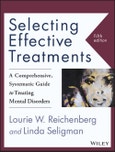Selecting Effective Treatmentsprovides a comprehensive resource for clinicians seeking to understand the symptoms and dynamics of mental disorders, in order to provide a range of treatment options based on empirically effective approaches. This new fifth edition has been updated to align with the latest changes to the DSM-5, and covers the latest research to help you draw upon your own therapeutic preferences while constructing an evidence-based treatment plan. Organized for quick navigation, each disorder is detailed following the same format that covers a description, characteristics, assessment tools, effective treatment options, and prognosis, including the type of therapy that is likely to be most successful treating each specific disorder. Updated case studies, treatments, and references clarify the latest DSM-5 diagnostic criteria, and the concise, jargon-free style makes this resource valuable to practitioners, students, and lay people alike.
Planning treatment can be the most complicated part of a clinician's job. Mental disorders can be complex, and keeping up with the latest findings and treatment options can itself be a full time job. Selecting Effective Treatments helps simplify and organize the treatment planning process by putting critical information and useful planning strategies at your fingertips
- Get up to speed on the latest changes to the DSM-5
- Conduct evidence-based treatment suited to your therapeutic style
- Construct Client Maps to flesh out comprehensive treatment plans
- Utilize assessment methods that reflect the changes to the DSM-5 multiaxial system
Effective treatment begins with strategic planning, and it's important to match the intervention to your own strengths, preferences, and style as much as to the client's needs. Selecting Effective Treatments gives you the latest information and crucial background you need to provide the evidence-backed interventions your clients deserve.
Table of Contents
Preface ix
Acknowledgments xi
Chapter 1 Introduction to Effective Treatment Planning 1
Chapter 2 Neurodevelopmental Disorders 33
Chapter 3 Schizophrenia Spectrum and Other Psychotic Disorders 69
Chapter 4 Bipolar and Related Disorders 103
Chapter 5 Depressive Disorders 145
Chapter 6 Anxiety Disorders 175
Chapter 7 Obsessive-Compulsive and Related Disorders 219
Chapter 8 Trauma- and Stressor-Related Disorders 245
Chapter 9 Dissociative Disorders 277
Chapter 10 Somatic Symptom and Related Disorders 289
Chapter 11 Feeding and Eating Disorders 311
Chapter 12 Elimination Disorders 341
Chapter 13 Sleep-Wake Disorders 353
Chapter 14 Sexual Dysfunctions 369
Chapter 15 Gender Dysphoria 383
Chapter 16 Disruptive, Impulse Control, and Conduct Disorders 393
Chapter 17 Substance-Related and Addictive Disorders 417
Chapter 18 Neurocognitive Disorders 461
Chapter 19 Personality Disorders 479
Chapter 20 Paraphilic Disorders 535
Appendix: Suicide Assessment and Prevention 551
About the Authors 565
Author Index 567
Subject Index 591







